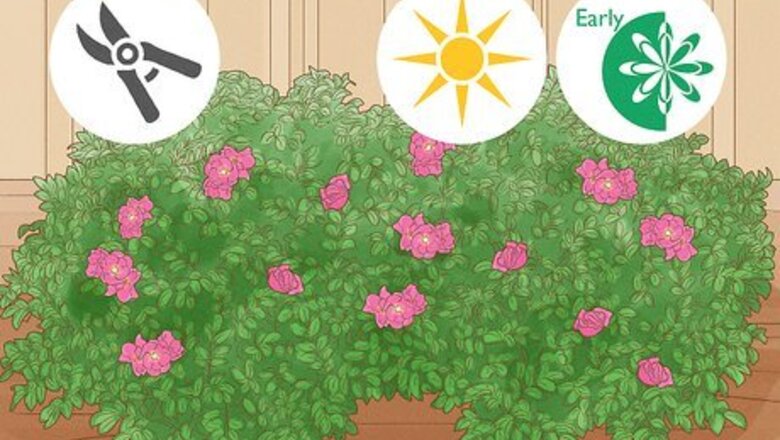
views
X
Trustworthy Source
Royal Horticultural Society
Leading gardening charity in the U.K. providing resources for identifying, growing and caring for flowers and other plants
Go to source
Essential Yearly Pruning
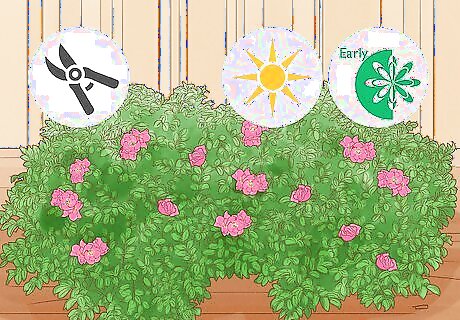
Know when to prune. Most pruning should be done once the plant enters its dormant season. This can be any point in time between late autumn and early spring. The best time to prune is in the early spring, after the danger of frost has passed. Pruning makes a plant vulnerable, and vulnerable plants tend to be weaker against the cold frosts of winter. If you live in a fairly warm climate, though, waiting until spring is not as significant an issue as long as the time you do prune is still in the dormant season. The only pruning you should worry about during the active growing season is deadheading. Deadheading, if performed, should be done on an "as needed" basis throughout the flowering season (summer).
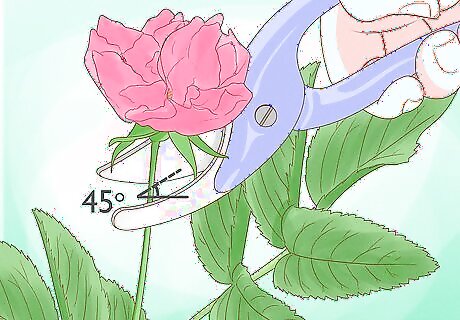
Determine whether or not to deadhead the blooms. You can deadhead faded blooms before they drop, but doing so is not strictly necessary for rosa rugosa shrubs. The rose hips are often considered part of the display or aesthetic appeal of the shrub, and deadheading would remove these hips. As such, you may opt to brush away the spent petals with your hands and leave the hips behind and intact. Deadheading prevents the bloom from going to seed and reduces the risk of disease, however, so you may still wish to do it. If you do decide to deadhead, snip off the spent bloom just beneath the rose hip, cutting the stem at a 45 degree angle. Do this continually throughout the flowering season, but stop sometime during the beginning of autumn, around October 1 or so. Stopping the practice will give the shrub enough time to harden itself in preparation for winter.
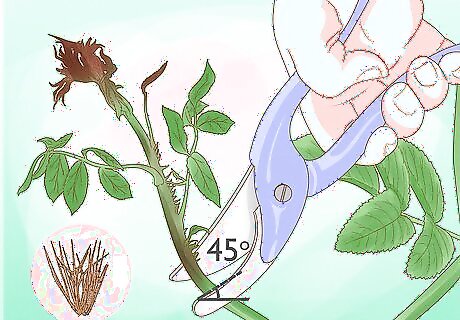
Remove unhealthy stems. Unhealthy stems include dead stems, dying stems, and diseased stems. Weak, thin stems are also considered unhealthy and should be removed each dormant season. Use a sharp cutting tool and cut stems at a 45 degree angle. You can usually determine if a cane or stem has died simply by looking at it. Dying canes are usually shriveled and either dark brown or black in color. Weak stems refer to any stem that is smaller than a standard pencil in diameter size. Dead canes should be completely removed at the ground level. Stems that are only partially dead should be cut back to a point just above the crossing of dead wood and live wood. Leave a small amount of the dead wood intact to protect the live wood from harm. If you are unable to tell where the dead wood ends and the live wood starts, gradually cut back the dead wood until you reach a point where the center of the trimmed stem is completely white, with no brown or black in sight.
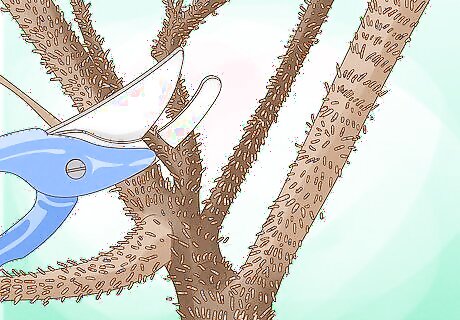
Prune problematic stems. In this case, problematic stems primarily refer to branches that intertwine or grow at abnormal angles. Wood that crosses other branches or rubs against other sections of the shrub can cause problems. Light and air are unable to flow freely in between these canes, and as a result, these sections of wood are more likely to become damaged or diseased. Cut crossing or rubbing stems down to a point below the problem area. If the stems grow back the following year in the same problematic matter, cut them down to ground level to prevent the problem from recurring the year after that.
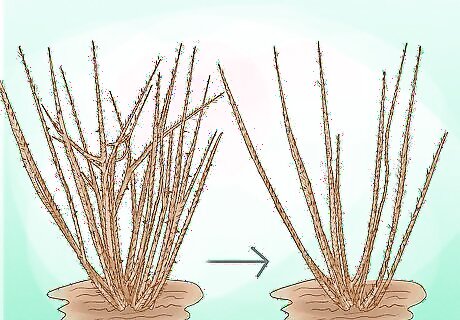
Thin out healthy stems as needed. The center of the shrub should be fairly open to promote air circulation and light penetration. If your rosa rugosa plant has grown too vigorously, you may need to trim away some older wood in the center of the plant, even if that wood appears healthy. Shrub roses like rosa rugosa will flower on both new and older wood, so most of the older wood should be allowed to develop and maintain itself naturally when possible. If the interior of the plant becomes too crowded, however, you may need to trim up some of the healthy growth in the center. Look for older, unproductive wood that did not bloom in the previous flowering season. Cut away two or three of these branches, cutting them down near ground level at a 45 degree angle.
Optional Renovation Pruning
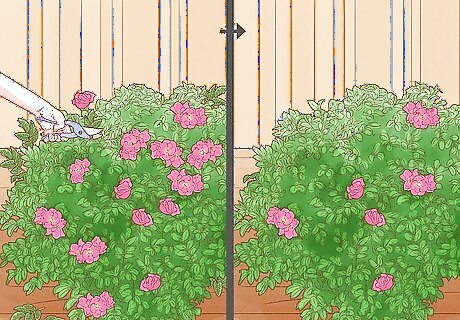
Understand the purpose of renovation pruning. Rosa rugosa shrubs often remain tidy without much interference, but if the roses start looking messy or overgrown, you will need to use renovation pruning to clean the plant up. Note that renovation pruning can cause a slight loss of flower production the following year, but it is still beneficial to your plant overall. Rose shrubs that are too overgrown essentially over-extend themselves and their resources. It may take a few years for the stress to show, but once it does, your plant will be much weaker and may have a hard time surviving. For the first two or three seasons, you should actually avoid renovation pruning. Doing so can allows the plant to establish itself more securely. Once the plant establishes itself, consider waiting every other year to do an overhaul on it. Renovation pruning can be performed once every year, but if new growth on the plant is not vigorous enough or if the plant grows weak, you may need to skip every other year.
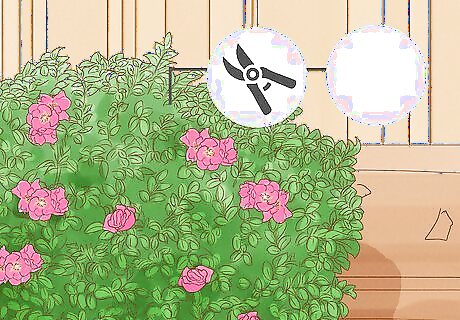
Wait until the dormant season. As with essential yearly pruning, you should wait until the plant enters its dormant stage before pruning it down. Waiting until the last frost passes in early spring is often the best option, but you should be able to prune the shrub at any point between late fall and early spring.
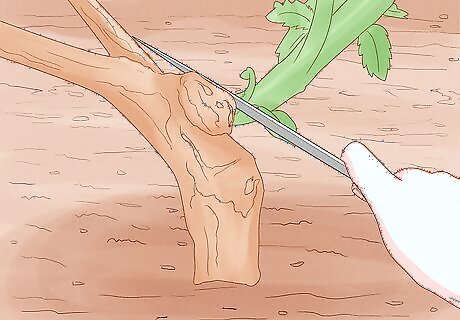
Remove any suckers. Suckers refer to stems that grow from the rootstock of the plant instead of the main stem. Cut these suckers off at the ground level. Aside from looking messy, the main problem with suckers is that they tend to grow too well and will deprive your main rosa rugosa shrub of the nutrients it needs. As a result, your main shrub will weaken and eventually die. Cutting suckers off at the ground will usually be enough, but if you want to be more thorough, dig down to the root from which the sucker originates and tear or cut it off at its point of origin.
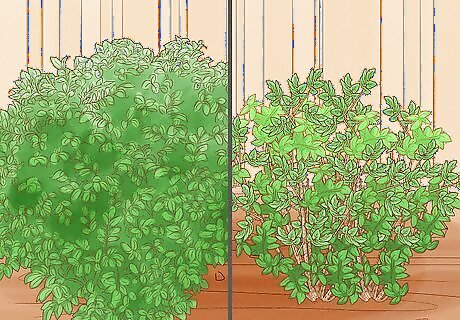
Trim up to one-third of the stems. Starting with the oldest stems, cut down between one-quarter and one-third of the stems on the plant. These stems should be trimmed down to ground level. In this instance, "ground level" refers to any height between the ground and 1.5 inches (4 cm) above the ground. Make each cut with sharp shears and at a 45 degree angle. Ideally, you should still try to cut the plant down to a bud. If you cannot find a bud that is low enough, however, the shrub should still be able to produce a new bud below the cut once the growing season starts again. If your plant is fairly weak, you may opt to trim the branches down to its new growth instead of cutting it all the way down to the ground.















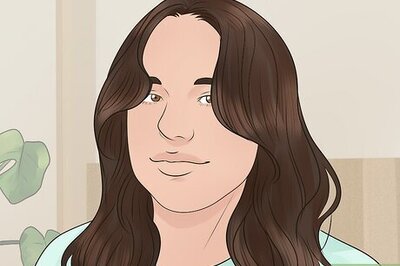
Comments
0 comment